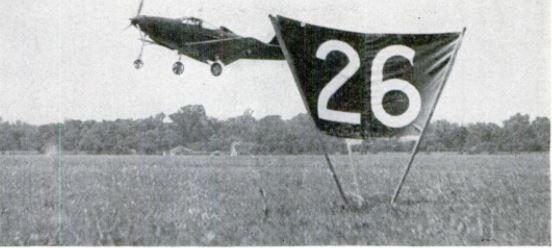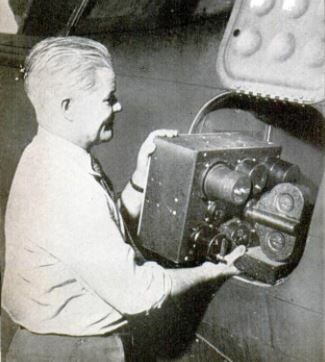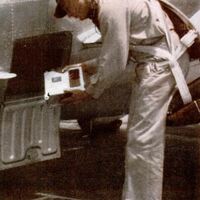-
Titolo
-
Training and jobs of U.S. Army test pilots
-
Article Title and/or Image Caption
-
Title: Testing the Hot Ships
-
extracted text
-
EVERY now and then in the Army Air
Corps there turns up a young pilot
who has a special knack with air-
planes. As his talent is recognized, word
gets around that here is a sweet flyer.
Often the same fellow has an equally out-
standing love for flying, which, after five,
six, or seven years, may be statistically
demonstrated. While other pilots have flown
hundreds of hours, he has flown thousands.
He has been in a plane at every opportunity,
adding to his experience and skill.
If this same superfiyer is also endowed
with an unusual degree of mental and emo-
tional stability, older heads in the Air Corps
exchange nods; shortly thereafter, the avi-
ator receives orders to proceed to Wright
Field, Dayton, Ohio, to become a test pilot.
He has hit the top flight in the flying pro-
fession.
To a man who loves airplanes, in an
Army whose average pilot is still wishing
for just one really up-to-the-minute plane
to fly, an assignment to Wright Field is
something like a ticket to Paradise—and
not by the crash route.
Your average tactical pilot flies a pursuit
plane, a bomber, a transport or observa-
tion ship. But the test pilot flies everything,
and always the latest model. All good
planes go to Dayton before they go any-
where else; and the test man must be ready
to fly every one of them, so well, up to its
maximum performance, that his report may
serve as the standard for the use of that
plane in tactical operations. If a tactical
pilot is confidentially informed, for instance,
that his new bomber has been taken off in
1,500 feet over a 50-foot obstacle, he knows
that he has to have a field of at least 2,000
feet to get that plane in and out with any
degree of safety and comfort.
The test pilot's day may start with a
flight in a Flying Fortress, followed by a
turn around the field in a tiny primary
trainer, and topped off with some acro-
batics in the latest model of P-40. The bulk
of his work consists of taking a new plane
model and putting it
through an elaborate
standardized routine of
tests, but he also has
to observe and com-
ment on that plane's
handling qualities. To
do that he must keep
himself attuned, by fly-
ing a great variety of
ships, to all the finest
differences of control.
Hands are as impor-
tant to a test flyer as to a surgeon. That
was indicated by Lieut. Col Stanley M.
Umstead, chief of the Army's test pilots,
when he took up the giant new bomber,
XB-19, for its maiden flight. Engineers, not
certain that mere manpower could handle
the 82-ton ship dependably, installed a sys-
tem of hydraulic controls. But one of the
first things Umstead did when he got in the
air was to cut out that system. He wanted
to fly by hand.
There are ordinarily about a dozen offi-
cers in the Flying Branch of the Materiel
Division, under Lieutenant Colonel Um-
stead; but half of them usually are engaged
in administrative work. On the other half
dozen falls the brunt of giving workouts to
the new models of military planes which
are pouring from American factories in an
increasing stream.
The test pilot pays dearly for his fun, in
terms of a rigorous self-discipline which is
almost beyond the comprehension of most
of us. A veteran flyer, selected for his skill,
he has to practice intensely for nearly three
months with planes of known performance,
before he is ready to start actual testing.
In less time than that, the greenest dodo
can learn to fly an airplane reasonably well.
In the course of a year, the test pilot
spends between 500 and 600 hours in the
“air, which is about twice as much flying as
is done by the average Army pilot. But that
doesn’t tell the story. In most flying, a man |
can relax and take it easy after he Is once
in the air. But the test pilot must concen-
trate every instant on his instruments.
About 75 hours of that in a month just
about touches the limit of human endurance.
To most of us the term “test pilot” is syn-
onymous with danger, but the flyers them.
selves say that most of the dangers have
been engineered out of their job. Also, the
most dangerous test—the dive—is per-
formed at the factory before the Army ac-
cepts delivery of a new plane. A pursuit
plane, for instance, must be able to dive at
160 percent of its rated level speed. That
is, a 400-mile-an-hour plane must dive at
640 miles an hour, and the manufacturer
hires a test pilot, for $10,000 or so, to risk
his life in proving the plane can do it. Once
this feat has been recorded by instruments,
there is no need of repeating it. There rare-
ly is occasion for an Army man to do one
of these power dives.
There is danger of mechanical failure, of
course, whenever new and untried equip-
ment is used. The test pilots admit there is
one especially breathless moment when they
are performing their landing and take-off
tests. When a plane is pulled off the ground,
at full power and maximum climb, its nose
is right up in the air; and a power failure |
at that instant would leave the pilot help-
less. Power failures do occur in new planes.
For no matter how thoroughly an engine |
has been tested, its installation in a new
model always has something untried about
it.
The Army flyers admit they are pretty
good at these landing and take-off tests.
One of them went to a factory not long ago
to start work on a new ship, it is related,
and found the private test flyers there in a
state of embarrassment. They had not been
able to get the ship off the ground within
several hundred feet of the required dis-
tance. The Army pilot took a few trial spins
and then pulled the plane up in 500 feet less
than was specified in the contract. Privately
employed flyers are likely to be gentle with
their employers’ property, but the Army
test men push the new ships right to the
limit. It is customary nowadays to burn up
two sets of brakes in the course of a series
of landing tests.
Modern high wing loadings make landing
and take-off a very fast matter. The tests
are made along a measured course, with
cameras and optical instruments set up to
record the point at which the plane clears
an imaginary 50-foot obstacle. Results are
obtained which sometimes leave experts
skeptical, unless they have actually seen the
tests. The new tricycle landing gear, with
the small wheel in front and the paired
wheels behind the center of gravity, makes
it possible, for instance, to come in at cruis-
ing speed and jam the brakes on full as soon
as the wheels are on the ground. In actual
service such feats would wear planes out in
very short order, but in a military emer-
gency the incredible often becomes neces-
sary.
Army test pilots are inclined to talk, not
about the thrills or
danger of their job, but of its exacting rou-
tine and the vast amount of information a
man must keep continually in the front of
his mind. It is all very well to fly many
different types of planes, but any man who
has tried to find the self-starter in a strange
car will realize how easily an aviator can go
wrong. The cockpit of a little pursuit plane
is a complicated maze of dozens of dials and
controls, while in a four-engine bomber the
number goes up in the hundreds, all of
which the pilot must have in mind. And
they are not the same on different planes.
The test pilot must spend hours a day
studying the ships he intends to fly.
The test flyer of a dozen years ago got
into a plane, opened the throttle wide, and
took off, to fly largely with his skill and in-
stincts. He had no retractable landing gear
to bother with, no flaps to lower, no variable-
pitch propeller, no supercharger, no mani-
fold pressure to watch, no radio. He landed
at slow speed. Each one of these improve-
ments means just so much more the pilot
must have in mind.
The standard performance test for mili-
tary planes is composed of 17 items, designed
to explore precisely every potentiality of the
ship, both as data for further development
and for guidance of the pilots who will oper-
ate the model in service. The test pilot must
turn in a report in which human error is
practically negligible. Two good pilots, test-
ing the same plane, will turn in results
which are nearly identical.
A fundamental testing process, for in-
stance, is the calibration of the air-speed
meter. Timed by a stop watch, the pilot
makes five two-way runs over a measured
course at an altitude of only 25 feet, keeping
altimeter and speed readings quite constant
during each run. On the flat ground near
Dayton this is quite possible on a perfect
flying day, but it takes a good man to do it.
In ordinary cross-country flying a man is
maintaining pretty level flight if he stays
within an altitude range of 250 feet. The
observations made in this test, with correc-
tions for temperature and pressure, serve as
the basis for speed tests at higher altitudes.
Climbing tests are still more difficult. The
basis for these are the saw-tooth climbs, 50
called because the barograph record of such
a flight looks like the blade of a saw. The
indicated speed at which a plane achieves
its maximum rate of climb varies with alti-
tude. So in the saw-tooth climb the airplane
is run through a specified altitude range at
various speeds, until the most efficient one
for each altitude is found.
Using the data thus obtained, the pilot is
ready for his check climb, which for most
men is the most difficult test of all. This is
to determine the true rate of climb from
ground level to the airplane's service ceiling.
The pilot must climb his plane steadily from
the ground, keeping his r.p.m. constant and
gradually reducing the air speed in accord-
ance with the best speeds indicated by the
saw-tooth climb, Watching the altimeter
closely, and flying his plane precisely all the
while, the pilot at each 1,000 feet of climb
must note down on his scratch pad the car-
buretor air temperature, the free air tem-
perature, and the manifold pressure. Mean-
while, at low altitude he has started breath-
ing through his oxygen mask, to store up a
surplus for that high altitude where the
pressure is so low that a man can't breathe
enough, even of pure oxygen, to supply his
needs.
Back on the ground, he plots his data on
a graph. If accurate, they will fall into a
smooth curve. But if any reading is out of
line, he has to fly back and check it again.
The service ceiling may be 30,000, per-
haps 35,000 feet. Even with improved oxy-
gen masks and enclosed cockpits, it is still
uncomfortable for the pilot at those alti-
tudes. More and more of the test pilot's job
is up at the ceiling; that is the frontier of
military aviation today, and if American
airplanes achieve supremacy in the battle
over Europe it will probably be because of
the turbo-supercharger which makes pos-
sible their efficiency at altitudes out of
reach. The test pilot works up there today,
and if war comes it will be a regular thing
for every military pilot.
Your working test pilot is usually strained
to the edge of human endurance. His flights
are not skylarking, but the tour of duty does
not last forever, and after two, three, or
four years of this sort of thing, he has a
training and knowledge of airplanes which
could be obtained in no other way. The Air
Corps needs men like that. From now on in
his career, you might almost say, the sky's
the limit.
-
Autore secondario
-
Hickman Powell (Article Writer)
-
Lingua
-
eng
-
Data di rilascio
-
1942-02
-
pagine
-
52-57, 220, 222
-
Diritti
-
Public Domain (Google Digitized)
-
Archived by
-
Roberto Meneghetti
-
Marco Bortolami (editor)





